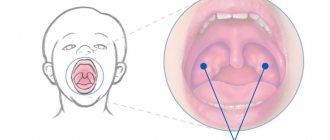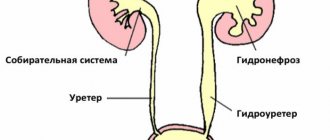The structure of the female pelvis
The pelvis is a closed ring formed by the pelvic bones, coccyx and sacrum. The pelvic bones are made up of the pubis, ilium and ischium. In addition to the main function - supporting the internal organs - the woman’s pelvis performs another very important function at one time - holding the baby during childbirth . Since the pelvis is adapted to perform this function, its cartilage and ligaments are able to “soften”. When a woman’s body releases a special hormone relaxin , the symphysis pubis, where the cartilage is located, also becomes softer and more mobile. As a result, the size of the pelvis gradually adjusts to the circumference of the child’s head.
Why does it occur
The pelvis is a kind of ring of several bones (iliac, ischial, pubic and sacrum). At the borders of each, semi-joints are formed, which include layers of cartilaginous tissue, but are characterized by low mobility. Under the influence of the gestagenic background, the properties of the tissues of the semi-joints change already in the early stages. This leads to their softening, divergence, increased mobility and the likelihood of inflammation. These processes are necessary for some increase in the size of the pelvis, which is later important during childbirth.
The symphysis pubis is located in the suprapubic region and has some features that contribute to the most frequent trauma and complications in this area. Namely:
- it bears the maximum load during pregnancy;
- its surface is small, which increases the pressure per unit area.
Under the influence of provoking factors, there is an increase in the production of a special protein - relaxin. It acts on cartilage fibers, reducing their strength and joint stability. Similar processes occur not only in the womb, but also in other joints and ligaments. But here the picture is most vivid due to the additional influence of the uterus and fetus. These are the main causes of symphysitis in pregnant women.
Symphysitis - what is it?
Symphysitis is an inflammatory process of the symphysis pubis. This is not a very common illness, but sometimes women notice the appearance of unpleasant symptoms.
The symphysis is a transitional fibrous or cartilaginous connection between bones. Accordingly, the pubic symphysis is the vertical connection of the upper branches of the pubic bones, located in the midline.
When a woman is expecting a child, the correct term to define such a pathological condition is “symphysiopathy”. The diagnosis of symphysiopathy during pregnancy is made if excessive softening of the cartilage occurs, and the distance between the bones increases by more than half a centimeter.
In non-pregnant women, the distance between the pubic bones is about 0.2 cm. In young women, at the age of about 20 years, this distance increases slightly (up to 0.6 cm), and after that it gradually decreases to normal levels.
When during childbirth there is a divergence of the symphysis pubis, and sometimes a rupture of the symphysis, this condition is defined as symphysiolysis .
In some cases, an inflammatory process develops in the places where the discrepancy occurred. This is the condition that is called symphysitis.
Causes of symphysitis after childbirth
It is worth noting that symphysitis can develop just after childbirth. Numerous factors may be the cause. For example, if the fetus is large enough and the pelvis is narrow, then as it passes during childbirth it can damage the birth canal.
It is worth considering that the physiological processes in the female body during pregnancy are caused by softening of the ligaments that hold the pubic bones at a distance from each other and swelling. As a result, the ligaments may partially lose their ability, and the bones simply separate. Due to swelling during pregnancy, the joints are also exposed to this factor, thereby increasing their mobility.
During preparation for childbirth, the pubic bones can diverge by a distance of up to 6 mm - this is normal. But after childbirth, the woman’s body must recover on its own and return to its original position. Unfortunately, this does not always happen, and help is needed to recover.
If a woman already has pathologies associated with diseases of bone structures or joints, injuries to the sacrum, as well as severe toxicosis, hormonal disorders or a lack of vitamins, then symphysitis may occur after childbirth.
Symptoms of symphysitis
If there is too much divergence of the symphysis pubis or inflammation of the symphysis, the following symptoms appear during pregnancy:
- nagging or shooting pain in the pubic area;
- pain increases during physical activity, especially if the hip is abducted to the side;
- discomfort and pain are also felt in the abdomen, thigh or back;
- pain occurs during sexual intercourse;
- Pain is felt during palpation of the symphysis pubis;
- the woman’s gait changes – she walks as if “waddling”;
- at rest, unpleasant sensations disappear;
- the act of defecation may be disrupted.
However, if you feel pain in the pubic area while carrying a baby, this condition is a variant of the norm, since this happens in about half of women. When the ligaments stretch and the symphysis softens, a certain discomfort is often felt, which intensifies before childbirth.
If the unpleasant feeling does not cause too much trouble, the expectant mother just needs to be patient a little. But if you experience unbearable pain, inability to move fully, or sleep disturbances, you should consult a doctor to determine whether such troubles are symptoms of symphysitis.
How dangerous is this?
The pubic symphysis or symphysis, popularly known as the pubis, is normally motionless. At the time of childbirth, bone tissue, including the pubic tissue, softens due to the action of the hormone relaxin. This is necessary so that the baby can pass through the birth canal. But sometimes excessive mobility and swelling of the symphysis pubis occurs - symphysitis.
Doctors cannot identify the exact cause of the pathology. Some believe that it is hereditary and also occurs due to problems with the musculoskeletal system.
Inflammatory symphysitis poses a danger to a pregnant woman:
- premature birth because the bones are unable to support the load;
- the child may develop pathologies and developmental deviations;
- high risk of infection of amniotic fluid and the baby;
- one of the serious complications is rupture of the symphysis;
- pathology is an indication for cesarean section, with severe symphysitis;
- a difficult postpartum period for a woman.
Why does symphysitis occur during pregnancy?
Not every mother experiences symptoms of symphysitis during pregnancy, and treatment for this condition is required. As a rule, discrepancy of the symphysis pubis develops under the influence of certain factors.
Photo of symphysitis during pregnancy
Hereditary disposition
It is generally accepted that this phenomenon is more often observed in women whose close relatives also experienced similar difficulties during pregnancy.
Features of the structure of connective tissue
Doctors are still arguing about the correctness of the definition of congenital weakness of ligaments and connective tissue. The fact is that this condition is diagnosed much more often than it actually occurs. Therefore, the question of how to determine symphysitis during pregnancy is very relevant.
However, already in childhood, people with this feature are more likely to experience subluxations and dislocations. They also more often develop heart valve pathologies, joint hypermobility, and prolapse of internal organs. During pregnancy, expectant mothers with dysplasia feel more pronounced discomfort in the ligament area.
Lack of calcium and vitamin D
In some cases, the symphysis softens due to calcium deficiency in the body. At the same time, the woman experiences other concomitant symptoms of calcium deficiency - deterioration in the condition of hair and nails, as well as fractures in pregnant women.
Kidney diseases
With kidney pathologies, for example, pyelonephritis , active release of minerals and protein occurs along with urine. This leads to the fact that the symphysis softens very intensively, and during pregnancy the symphysis pubis can diverge.
Previously experienced pelvic injuries
If a woman has had such injuries at one time, this can subsequently lead to the development of symphysiopathy during pregnancy.
Multiple births
Mothers with many children often suffer from this pathology during pregnancy.
Therapy
A treatment plan for symphysitis during pregnancy is drawn up after diagnosis. This mainly involves taking vitamins and calcium-containing medications. Medicines intended to relieve inflammation are prohibited during the entire period of pregnancy. Therefore, therapeutic measures are carried out only in order to reduce the discomfort of the woman in labor. It is worth noting that symphysitis does not affect the development of the baby in any way.
Physical activity and carrying heavy objects are also limited. In the last months of pregnancy, a special bandage is prescribed to support the abdomen to reduce pain due to symphysitis during pregnancy. In addition, special exercises for strengthening muscles and massage of the lumbar spine have proven themselves to be effective. After childbirth, the pain goes away on its own.
How does symphysitis affect pregnancy and childbirth?
The normal divergence of the pelvic bones during pregnancy does not affect the gestation process. Some women note that when the pelvic bones diverge during pregnancy, the sensations are uncomfortable.
Symphysiopathy also does not have a negative effect on pregnancy, it only worsens the woman’s general condition. However, with excessive stretching of the symphysis pubis during pregnancy, it becomes so thin that during childbirth, when the pelvic bones begin to diverge, cartilage rupture occurs - symphysiolysis .
When such an injury occurs, a woman cannot work normally for several months and finds it difficult to move. In expectant mothers with a narrow pelvis, the likelihood of rupture of the joint increases if a large fetus develops - more than 4 kg. In this situation, there is insufficient divergence of the pelvic bones during pregnancy for the birth to proceed normally. Therefore, experts advise performing a cesarean section if grade 2 and 3 symphysiopathy develops, or if a large fetus develops. In this case, it is possible to significantly reduce the trauma of mother and baby during childbirth.
Treatment
Symphysiopathy is a rare condition that exists for a certain amount of time (last trimester of pregnancy) and then disappears without surgery. Many pregnant women find it difficult to wait for the pain to go away, because it interferes with leading a normal lifestyle.
Due to pregnancy, the expectant mother cannot take anti-inflammatory and painkillers, as they can negatively affect the development of the fetus. For this reason, therapeutic techniques are quite limited.
Specialists for symphysitis during pregnancy adhere to the following plan:
- Pregnant women are prescribed calcium supplements. This method has a significant drawback - experts recommend that expectant mothers in the last weeks of pregnancy reduce the amount of calcium-containing foods they consume in order to prevent complications during childbirth. Calcium strengthens a woman’s bone tissue, but at the same time it cannot be intentionally compacted, since for normal delivery it must be elastic. Also, excessive calcium intake hardens the baby's skull, which can cause problems with its movement through the birth canal.
- Gymnastics will help reduce the severity of clinical symptoms and slow down the stretching process. A certain set of exercises is aimed at strengthening the muscles of the pelvis, hips and lower back. It is recommended to do gymnastics under the supervision of an instructor in a specialized medical institution. In this case, it is necessary to minimize any physical activity not related to therapeutic exercises.
- Wearing a bandage is a prerequisite for treatment. It serves as excellent support for muscles weakened by disease.
What is the danger of symphysis rupture?
The divergence of the symphysis pubis after or before childbirth causes a lot of unpleasant symptoms in a young mother. However, this condition is not a threat to health or life. But if the divergence of the pelvic bones leads to rupture of the symphysis pubis during childbirth, then we are talking about a serious injury, that is, a pelvic fracture .
Photo of where the pubic bone is located
Provided that the bones have separated by 2 cm, we are talking about a stable fracture that rarely provokes complications. But if the symphyosis has diverged by 5 cm or more, then this condition seriously threatens health. Therefore, treatment of symphysitis after childbirth depends on the woman’s condition – sometimes surgical intervention is required.
After all, when the edges of the bones rupture, they sometimes damage the bladder, urethra, and clitoris. Hemorrhages sometimes develop in the joint area, and this subsequently leads to the development of arthritis . True, such a serious condition requiring surgery is quite rare.
How to identify such a pathology?
If a pregnant woman complains of pain and swelling in the pubic area, as well as difficulty moving, the doctor will prescribe the necessary tests.
Ultrasound
When performing an ultrasound of the symphysis pubis, the distance between the bones of the pubis is determined. The specialist also sees indirect signs of the inflammatory process. It often happens that with a small discrepancy the patient feels very severe pain. But with a strong discrepancy, the pain sensations, on the contrary, are not too pronounced.
Therefore, after an ultrasound of the symphysis pubis is performed during pregnancy, specialists indicate only the size of the divergence of the symphysis pubis.
When establishing the final diagnosis, the severity of symptoms is also taken into account.
X-ray of the pelvic bones
It is used, as a rule, after childbirth to diagnose a rupture of the symphysis, and then monitor the treatment process. During pregnancy X-ray pelviometry , that is, measurement of the pelvis, is performed less frequently. This condition makes it possible to further assess the correspondence of the pelvic circumference and the size of the fetal head.
CT and MRI
After the baby is born, methods are used that allow more accurate assessment of the results. With the help of such a study, it is possible not only to provide clear monitoring of the effectiveness of treatment, but also to determine the presence of other pathological changes in the pelvic area.
Folk remedies for symphysitis
In folk medicine, there are several remedies that help cope with the disease. They can only be used after consultation with a specialist.
Traditional healers recommend increasing the consumption of the following products:
- goat cheese;
- fish;
- almond;
- prunes.
Use these products in different combinations and prepare dishes from them. Continue eating them even if the pain has subsided.
Corvalol will help reduce pain during illness. Rub it into your pubis with light massaging movements several times a day.
A honey-sesame mixture is also effective in treatment. Below is her recipe.
You will need:
- sesame seeds - 0.1 kg;
- honey - 2-3 tsp.
How to cook: Combine ingredients.
How to use: Eat the resulting mixture throughout the day. Use the product until the pain disappears.
Prevention of symphysitis plays an important role in preventing pathology
Differential diagnosis
Sometimes painful sensations similar to those that occur with symphysitis provoke other diseases. A woman should definitely tell her gynecologist about the appearance of pain and discomfort in the pelvic area. In such a situation, a specialist conducts an examination and prescribes the necessary examinations. Pubic pain is also caused by the conditions described below.
Urinary and genital tract infections
For this reason, pubic pain may also develop. With cystitis , pain, burning, stinging, and tingling in the groin area are very common. Cystitis is caused by sexually transmitted infections or E. coli, and during pregnancy this condition develops quite often. With such signs, it is imperative to conduct a test for infection.
Lumbago
Back pain that develops acutely. They are provoked by diseases of the spine ( intervertebral hernia , osteochondrosis ). The pain often radiates to other organs - the groin, limbs, abdomen. With lumbago , urination and defecation disorders are common.
Sciatica (sciatica)
With sciatica, pain develops in the area of the sciatic nerve. Pain sensations spread along the leg to the lower leg from the groin and tailbone. This sign often indicates the development of arthritis, muscle damage, and pelvic tumors.
Osteomyelitis, bone diseases (tuberculosis lesions)
Although such manifestations are rare, the doctor should take them into account during differential diagnosis.
To exclude or confirm any of the listed diseases, X-rays, ultrasound, and laboratory tests are necessary.
Exercises
There are special gymnastics that help reduce pain. It can be performed only with the permission of the attending physician and only if it does not cause discomfort:
- "Kitty." This exercise is performed in the knee-elbow position on a flat, hard surface. You need to alternately bend and arch your back and shoulders. Repeat 10 times.
- "Bridge". While lying on your back, you need to bend your knees (your feet remain on the floor), raise your pelvis, hold this position for a few seconds, then slowly lower your pelvis to the floor. Repeat 10 times.
- "Intimate gymnastics." Lying on her back, the woman tenses her hip muscles, as if she wants to hold back urination. You need to repeat this exercise 20 times.
How to treat symphysitis?
As a rule, symphysiopathy that develops during pregnancy disappears on its own approximately 5 months after birth. In some cases, the pain lasts longer – up to a year. In such a situation, treatment is not required - everything gradually returns to normal on its own. And in case of rupture of the pubic symphysis, therapy depends on its degree.
How to treat symphysiopathy in pregnant women?
To alleviate the unpleasant symptoms of symphysis divergence, you need to follow these recommendations:
- try to limit the period of sitting in one place, the duration of walking, going up and down the stairs;
- consume foods containing a lot of calcium, sometimes you need to take calcium supplements; however, the use of supplements must be strictly controlled by the doctor, because too much calcium is harmful to the developing fetus, especially in the third trimester; It is not recommended to use calcium supplements in the last few weeks before childbirth;
- distribute body weight evenly in a stationary position - sitting or standing;
- control your weight, because excess body weight increases the load on the ligaments and joints, resulting in pain;
- From about 26-28 weeks, you should wear a special prenatal bandage, which will help reduce pressure on the symphysis and reduce pain.
The treatment process is necessarily monitored by a gynecologist, as well as an orthopedist-traumatologist. In some cases, the patient may need to consult a neurologist and physiotherapist.
What exercises will help reduce pain?
The expectant mother can perform a special set of exercises to help reduce the severity of discomfort.
Raising the pelvis
You need to lie down and bend your knees. Then slowly raise your pelvis, fixing it at the top point. After this, the pelvis is lowered. The exercise must be repeated several times.
Cat pose
Straighten your back and shoulders while standing on your knees and elbows. Arch your back, tensing your abdominal muscles and lowering your head down. Repeat several times.
Kegel exercises
To perform this exercise correctly, you need to simulate the retention and release of urine. Kegel exercises effectively strengthen the pelvic floor muscles, reduce pelvic instability, and relieve stress.
All these exercises can be performed if the woman does not feel pain during the process, and there are no contraindications.
How to treat symphysiolysis after childbirth
To alleviate the condition after the birth of the baby, a number of methods are taken.
Bandages
You need to wear a special bandage that grips the trochanters of the femur. It will help not only reduce pain, but also reduce the risk of further discrepancy. The bandage will help speed up the process of fusion of the symphysis.
Anesthesia
Nonsteroidal anti-inflammatory drugs (NSAIDs) are used to relieve pain. You can use Buprofen , Paracetamol other drugs. But such remedies are used only if the pain is severe and prolonged. It is important to consider that prolonged and uncontrolled use of such drugs can provoke the development of stomach ulcers and have a bad effect on the liver. Nursing mothers should consult a doctor before using such medications, since some painkillers should not be taken during lactation .
Physiotherapy
To activate the overgrowth of the symphysis, magnetic therapy and other types of physical therapy are used. However, such methods are effective provided there is bed rest and fixation of the pelvic bones.
Gentle mode
If the bones are not too far apart, it is enough just to reduce physical activity, use a cane or other means.
Bed rest
If the discrepancy is severe, it is necessary to adhere to strict bed rest. A special hammock equipped with weights suspended crosswise will help speed up the fusion process. This device gradually brings the pubic bones together.
Controllable pelvic belt
To enhance the effect of the hammock, a special pelvic belt with several belts is used, to which weights are attached. This way you can adjust the tension of different parts of the belt, and the healing of the gap is accelerated.
Surgical treatment
If treatment was not carried out on time, and the woman continues to feel pain and limit movement due to the rupture, surgical intervention is performed. To restore the integrity of the pelvis, rods and plastic materials are used during surgery.
Bandage
One of the main preventive measures is wearing a bandage made of special dense fabric. Wearing a bandage for symphysitis during pregnancy begins in the third trimester, and for prevention - in the second. It is selected individually for each woman. It should not tighten the stomach too much and cause discomfort. Put the bandage on while lying on your back, slowly pulling it onto your stomach. It should be tight enough and perform a supportive function well. In this case, a hand should pass between the body and the bandage. If a woman is resting, it is important to take it off so as not to put unnecessary stress on the body.
View gallery
Prevention of symphysitis
The development of symphysiopathy, unfortunately, cannot be prevented, since clear reasons for the development of this condition have not yet been established. However, some recommendations must be followed to reduce the likelihood of symphysis rupture.
- It is important to plan your pregnancy and be examined for infections and thyroid diseases before conceiving.
- If necessary, take iron, calcium, iodine supplements.
- Eat right both at the planning stage and during pregnancy and lactation.
- For patients with diabetes , monitor glucose levels, because large children are often born with diabetes.
- Perform an ultrasound of the fetus in the last weeks of pregnancy to determine its expected weight.
- If a woman has previously suffered fractures, serious injuries, or had problems during childbirth before, she must tell her doctor about this.
- If you experience pain in the pubic area, swelling or limited movement, it is important to consult a doctor immediately.
- It is important to consult a specialist in a timely manner about methods of delivery. A caesarean section may be the best option.
Recommendations
There is a list of recommendations to help reduce pain with symphysitis during pregnancy:
- do not sit with your legs crossed;
- do not stay in one position for a long time, change your position often;
- when standing, try to distribute the weight evenly on both legs;
- do not sit or lie on too hard surfaces;
- if possible, buy an orthopedic mattress during pregnancy;
- watch your weight;
- walk more often, the sun's rays promote the production of vitamin D, which in turn helps the absorption of calcium;
- eat more foods containing calcium;
- wear a bandage;
- do not neglect therapeutic exercises;
- climb stairs less;
- take warm baths, they relieve pain in the hip joints;
- when walking, move smoothly, without sudden movements, try to walk in small steps;
- at night, according to reviews, with symphysitis during pregnancy, women are advised to place a pillow between their legs, which will make sleep more comfortable;
- when walking for a long time, stop often to rest;
- while lying down, raise your legs;
- while resting, place a towel roll under the buttocks, this will lift the pelvis and reduce pain.











